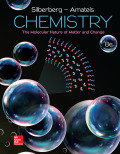
Concept explainers
Interpretation:
The similarity and difference between ultraviolet and microwave radiations are to be determined.
Concept introduction:
1) Electromagnetic waves travel at the speed of light.
2) Electromagnetic waves are transverse in nature.
3) Electromagnetic waves may be polarized.
4) Electromagnetic waves are not deflected by an electric or magnetic field.
5) Electromagnetic waves need no medium for propagation.
Answer to Problem 7.1P
The similarity between ultraviolet and microwave radiations lies in the fact that both radiations are electromagnetic in nature.
The difference between the two lies in their wavelength and frequency.
Explanation of Solution
Ultraviolet and microwave radiations are among the seven electromagnetic radiations. Hence they are similar because both are composed of oscillating electric and magnetic fields that are perpendicular to each other.
Ultraviolet and microwave radiations differ in their wavelength and frequencies. The wavelength range of microwave radiation is much greater than the wavelength range of ultraviolet radiation, whereas the frequency range of ultraviolet radiation is much greater than that of the microwave.
The similarity between ultraviolet and microwave radiations lies in the fact that both radiations are electromagnetic in nature.
The difference between the two lies in their wavelength and frequency.
Want to see more full solutions like this?
Chapter 7 Solutions
EBK CHEMISTRY: THE MOLECULAR NATURE OF
 ChemistryChemistryISBN:9781305957404Author:Steven S. Zumdahl, Susan A. Zumdahl, Donald J. DeCostePublisher:Cengage Learning
ChemistryChemistryISBN:9781305957404Author:Steven S. Zumdahl, Susan A. Zumdahl, Donald J. DeCostePublisher:Cengage Learning ChemistryChemistryISBN:9781259911156Author:Raymond Chang Dr., Jason Overby ProfessorPublisher:McGraw-Hill Education
ChemistryChemistryISBN:9781259911156Author:Raymond Chang Dr., Jason Overby ProfessorPublisher:McGraw-Hill Education Principles of Instrumental AnalysisChemistryISBN:9781305577213Author:Douglas A. Skoog, F. James Holler, Stanley R. CrouchPublisher:Cengage Learning
Principles of Instrumental AnalysisChemistryISBN:9781305577213Author:Douglas A. Skoog, F. James Holler, Stanley R. CrouchPublisher:Cengage Learning Organic ChemistryChemistryISBN:9780078021558Author:Janice Gorzynski Smith Dr.Publisher:McGraw-Hill Education
Organic ChemistryChemistryISBN:9780078021558Author:Janice Gorzynski Smith Dr.Publisher:McGraw-Hill Education Chemistry: Principles and ReactionsChemistryISBN:9781305079373Author:William L. Masterton, Cecile N. HurleyPublisher:Cengage Learning
Chemistry: Principles and ReactionsChemistryISBN:9781305079373Author:William L. Masterton, Cecile N. HurleyPublisher:Cengage Learning Elementary Principles of Chemical Processes, Bind...ChemistryISBN:9781118431221Author:Richard M. Felder, Ronald W. Rousseau, Lisa G. BullardPublisher:WILEY
Elementary Principles of Chemical Processes, Bind...ChemistryISBN:9781118431221Author:Richard M. Felder, Ronald W. Rousseau, Lisa G. BullardPublisher:WILEY





